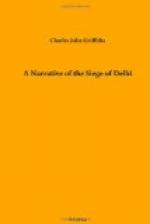Our investment, if such it could be called, was therefore only partial, being confined to that portion of the city extending from the water battery near Selimgarh Fort to the Ajmir Gate, which was just visible from the extreme right of the ridge. This part was defended by, I think, four bastions, named, respectively, the Water, Kashmir, Mori, and Burn. Three gates besides the Lahore gave egress to the mutineers when making sorties, the afterwards celebrated Kashmir Gate, the Kabul and the Ajmir Gates.
The Hindoo Rao’s house, on the right of the ridge where it sloped down into the plain, was the key of our position, and was defended with great bravery and unflinching tenacity throughout the whole siege by the Sirmoor battalion of Goorkhas, and portions of the 60th Royal Rifles and the Guide Corps. Incessant day and night attacks were here made by the enemy, who knew that, were that position turned, our camp—in fact, our very existence as a besieging force—would be imperilled.
But no assault, however strong and determined, made any impression on the men of these gallant regiments, led by Major Reid, the officer commanding the Sirmoor battalion. They lost in killed and wounded a number far out of all proportion to that of any other corps before Delhi, and must in truth be reckoned the heroes of the siege.
The Goorkhas are recruited in the mountain districts of the Himalayas, in the kingdom of Nepal. They are short and squat in figure, never more than five feet three inches in height, of dark complexion, with deep-set eyes and high cheek-bones denoting their affinity to the Turanian race. Good-humoured and of a cheerful disposition, they have always been great favourites with the European soldiers, whose ways and peculiarities they endeavour to imitate to a ludicrous extent. In battle, as I have often seen them, they seem in their proper element, fierce and courageous, shrinking from no danger. They carried, besides the musket, a short, heavy, curved knife called a kukri, a formidable weapon of which the sepoys were in deadly terror. As soldiers they are second to none, amenable to discipline and docile, but very tigers when roused; they fought with unflinching spirit during the Mutiny, freely giving up their lives in the service of their European masters.
And now that I have endeavoured, for the purposes of this narrative, to explain our position and that of the enemy, I shall proceed to recount, as far as my recollection serves, the main incidents of the siege, and more particularly those in which I personally took part.
The camp of my regiment was pitched, as I have said, on the extreme left of the besieging force, on the rear slope of the ridge. We were completely hidden from any view of the city, and but for the sound of the firing close by, which seldom ceased day or night, might have fancied ourselves far away from Delhi.
Cholera still carried off its victims from our midst, and the very night of our arrival I performed the melancholy duty of reading the Burial Service over five gallant fellows of the Grenadier Company who had died that day from the fell disease.




